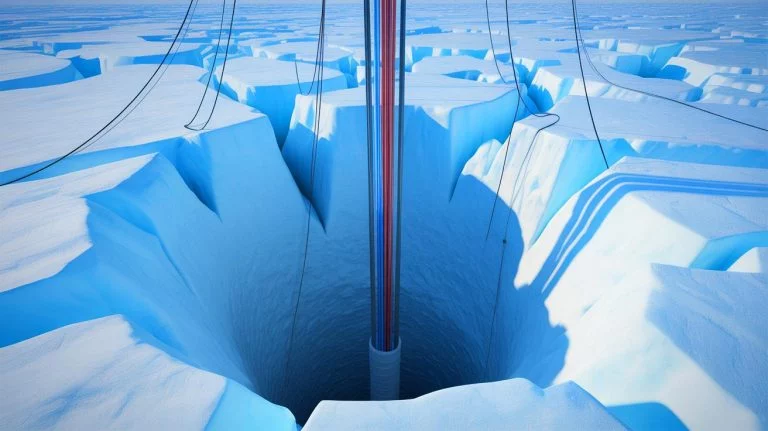| IN A NUTSHELL |
|
In a groundbreaking study, researchers have detected a series of “ice quakes” within the Greenland Ice Sheet. These seismic events, akin to earthquakes, occur when ice fractures and slabs grind against one another. This discovery sheds light on the jerky movement of Greenland’s frozen rivers toward the ocean. By utilizing a fiber-optic cable within a deep borehole, scientists captured these elusive quakes, offering new insights into the dynamics of ice streams. This research not only enhances our understanding of glacial movement but also addresses crucial questions about sea level rise and climate change.
Unveiling the Mysteries of Ice Quakes
Ice quakes in Greenland have remained largely undetected until now, primarily due to a thick layer of volcanic particles. These particles, buried beneath the ice, originated from Mount Mazama’s eruption around 7,700 years ago. This volcanic debris blocks seismic waves from reaching the surface, obscuring the quakes beneath. However, recent advancements have allowed researchers to lower a fiber-optic cable into a 1.7-mile-deep borehole, revealing the hidden seismic activities.
Andreas Fichtner, a geophysics professor, notes that these volcanic particles might not only block seismic waves but could also initiate the quakes. Impurities such as sulphates destabilize the ice, leading to small fractures. The revelation of this relationship between volcanic eruptions and ice dynamics marks a significant breakthrough in glaciology. Understanding these interactions is critical, as ice quakes have the potential to trigger a domino effect, propagating through the ice sheet.
Jaya Anand Singh’s Research Path : A Journey from Curiosity to Contribution
The Role of Ice Streams in Sea Level Rise
Ice streams are crucial components of the Greenland Ice Sheet, acting as conduits for ice discharge into the ocean. This process directly influences sea level rise, a pressing concern in the context of global warming. The Northeast Greenland Ice Stream, the island’s largest frozen river, plays a vital role in this mechanism. Researchers are keen on understanding how ice quakes affect the movement of these streams, as their dynamics significantly impact climate models.
Previously, scientists believed that ice streams flowed slowly, akin to viscous honey. However, the discovery of ice quakes challenges this notion, suggesting a more complex, stick-slip motion. This newfound understanding necessitates a reevaluation of existing models, which are crucial for predicting future climate scenarios. As ice streams dump substantial ice into the ocean, refining these models is essential for accurate sea level rise predictions.
The Science Behind Fiber-Optic Detection
The innovative use of fiber-optic cables has revolutionized the detection of seismic activities within ice. By continuously recording seismic signals, researchers have unveiled the previously hidden world of ice quakes. This technology allows for real-time monitoring, providing valuable data on the ice sheet’s dynamics. Over 14 hours of continuous recording, scientists gathered insights that challenge conventional theories about glacial movement.
This method’s success underscores the importance of technological advancements in environmental research. It opens new avenues for studying other areas where seismic activities remain obscured. By applying this technique, scientists can gain a more comprehensive understanding of the processes governing ice sheet behavior, ultimately contributing to better climate change predictions.
Implications for Climate Change Research
The Greenland Ice Sheet is a massive body of ice covering 80% of the island. Its meltwater is a significant contributor to global sea level rise. Since the 1990s, it has accounted for a 0.6-inch increase in sea levels. With enough ice to raise sea levels by 23 feet, understanding its dynamics is crucial. The discovery of ice quakes provides a new dimension to this understanding, offering insights into the ice sheet’s internal movements.
Olaf Eisen, a glaciology professor, emphasizes the significance of these findings. By uncovering the role of ice quakes, researchers can better comprehend the deformation of ice streams. This knowledge is vital for developing more accurate models to assess climate change impacts. As the scientific community continues to explore these dynamics, the implications for future research are profound.
The revelation of ice quakes within the Greenland Ice Sheet marks a pivotal moment in glaciology. This discovery challenges existing paradigms and highlights the intricate relationships between volcanic activity and ice dynamics. As researchers delve deeper into these seismic events, how will this new understanding reshape our predictions for sea level rise and climate change adaptation strategies?
Did you like it? 4.7/5 (26)







Wow, ice quakes? Sounds like Mother Nature’s way of keeping us on our toes! 😅❄️
How do these ice quakes compare to regular earthquakes in terms of magnitude?
Could this new discovery help us predict future sea level rise more accurately?
So, when can we expect the movie “Ice Quake” to come out? 🎬😂
Thank you for shedding light on such an important topic! 🌍🙏
I wonder if these findings could affect our understanding of other icy regions, like Antarctica?
Great, another thing to worry about with climate change… 😒
Is it possible to hear these ice quakes, or are they too deep?
Interesting read! Could this research impact the way we build on frozen terrains?
Are these ice quakes dangerous for humans living in Greenland?